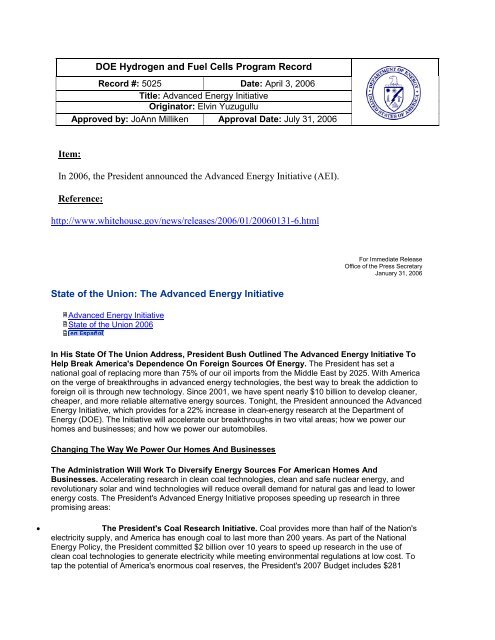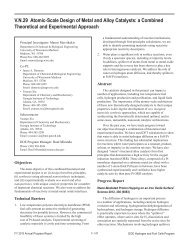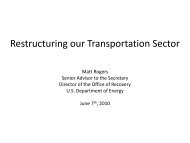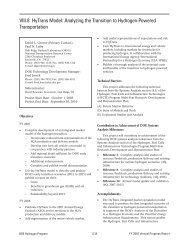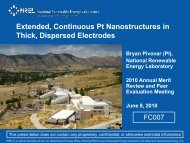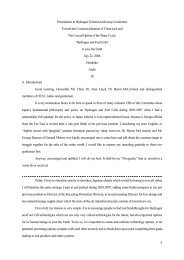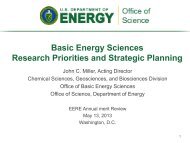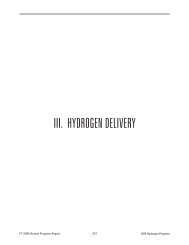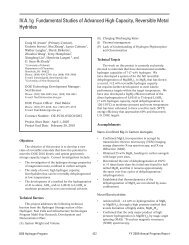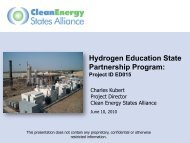Advanced Energy Initiative - DOE Hydrogen and Fuel Cells Program ...
Advanced Energy Initiative - DOE Hydrogen and Fuel Cells Program ...
Advanced Energy Initiative - DOE Hydrogen and Fuel Cells Program ...
Create successful ePaper yourself
Turn your PDF publications into a flip-book with our unique Google optimized e-Paper software.
<strong>DOE</strong> <strong>Hydrogen</strong> <strong>and</strong> <strong>Fuel</strong> <strong>Cells</strong> <strong>Program</strong> Record<br />
Record #: 5025 Date: April 3, 2006<br />
Title: <strong>Advanced</strong> <strong>Energy</strong> <strong>Initiative</strong><br />
Originator: Elvin Yuzugullu<br />
Approved by: JoAnn Milliken Approval Date: July 31, 2006<br />
Item:<br />
In 2006, the President announced the <strong>Advanced</strong> <strong>Energy</strong> <strong>Initiative</strong> (AEI).<br />
Reference:<br />
http://www.whitehouse.gov/news/releases/2006/01/20060131-6.html<br />
For Immediate Release<br />
Office of the Press Secretary<br />
January 31, 2006<br />
State of the Union: The <strong>Advanced</strong> <strong>Energy</strong> <strong>Initiative</strong><br />
<strong>Advanced</strong> <strong>Energy</strong> <strong>Initiative</strong><br />
State of the Union 2006<br />
In His State Of The Union Address, President Bush Outlined The <strong>Advanced</strong> <strong>Energy</strong> <strong>Initiative</strong> To<br />
Help Break America's Dependence On Foreign Sources Of <strong>Energy</strong>. The President has set a<br />
national goal of replacing more than 75% of our oil imports from the Middle East by 2025. With America<br />
on the verge of breakthroughs in advanced energy technologies, the best way to break the addiction to<br />
foreign oil is through new technology. Since 2001, we have spent nearly $10 billion to develop cleaner,<br />
cheaper, <strong>and</strong> more reliable alternative energy sources. Tonight, the President announced the <strong>Advanced</strong><br />
<strong>Energy</strong> <strong>Initiative</strong>, which provides for a 22% increase in clean-energy research at the Department of<br />
<strong>Energy</strong> (<strong>DOE</strong>). The <strong>Initiative</strong> will accelerate our breakthroughs in two vital areas; how we power our<br />
homes <strong>and</strong> businesses; <strong>and</strong> how we power our automobiles.<br />
Changing The Way We Power Our Homes And Businesses<br />
The Administration Will Work To Diversify <strong>Energy</strong> Sources For American Homes And<br />
Businesses. Accelerating research in clean coal technologies, clean <strong>and</strong> safe nuclear energy, <strong>and</strong><br />
revolutionary solar <strong>and</strong> wind technologies will reduce overall dem<strong>and</strong> for natural gas <strong>and</strong> lead to lower<br />
energy costs. The President's <strong>Advanced</strong> <strong>Energy</strong> <strong>Initiative</strong> proposes speeding up research in three<br />
promising areas:<br />
• The President's Coal Research <strong>Initiative</strong>. Coal provides more than half of the Nation's<br />
electricity supply, <strong>and</strong> America has enough coal to last more than 200 years. As part of the National<br />
<strong>Energy</strong> Policy, the President committed $2 billion over 10 years to speed up research in the use of<br />
clean coal technologies to generate electricity while meeting environmental regulations at low cost. To<br />
tap the potential of America's enormous coal reserves, the President's 2007 Budget includes $281
million for development of clean coal technologies, nearly completing the President's commitment 4<br />
years ahead of schedule.<br />
o<br />
The President's 2007 Budget Includes $54 Million For The FutureGen<br />
<strong>Initiative</strong>. The FutureGen initiative is a partnership between government <strong>and</strong> the private sector to<br />
develop innovative technologies for an emissions-free coal plant that captures the carbon dioxide it<br />
produces <strong>and</strong> stores it in deep geologic formations.<br />
• The President's Solar America <strong>Initiative</strong>. The 2007 Budget will propose a new $148<br />
million Solar America <strong>Initiative</strong> – an increase of $65 million over FY06 – to accelerate the development<br />
of semiconductor materials that convert sunlight directly to electricity. These solar photovoltaic "PV"<br />
cells can be used to deliver energy services to rural areas <strong>and</strong> can be incorporated directly into building<br />
materials, so that there can be future "zero energy" homes that produce more energy than they<br />
consume.<br />
• Exp<strong>and</strong>ing Clean <strong>Energy</strong> from Wind. The 2007 Budget includes $44 million for wind<br />
energy research – a $5 million increase over FY06 levels. This will help improve the efficiency <strong>and</strong><br />
lower the costs of new wind technologies for use in low-speed wind environments. Combined with<br />
ongoing efforts to exp<strong>and</strong> access to Federal l<strong>and</strong>s for wind energy development, this new funding will<br />
help dramatically increase the use of wind energy in the United States.<br />
Changing The Way We Power Our Automobiles<br />
• We Are On The Verge Of Dramatic Improvements In How We Power Our<br />
Automobiles, And The President's <strong>Initiative</strong> Will Bring Those Improvements To The Forefront.<br />
The United States must move beyond a petroleum-based economy <strong>and</strong> develop new ways to power<br />
automobiles. The President wants to accelerate the development of domestic, renewable alternatives to<br />
gasoline <strong>and</strong> diesel fuels. The Administration will accelerate research in cutting-edge methods of<br />
producing "cellulosic ethanol" with the goal of making the use of such ethanol practical <strong>and</strong> competitive<br />
within 6 years. The Administration will also step up the Nation's research in better batteries for use in<br />
hybrid <strong>and</strong> electric cars <strong>and</strong> in pollution-free cars that run on hydrogen.<br />
• The Biorefinery <strong>Initiative</strong>. To achieve greater use of "homegrown" renewable fuels in<br />
the United States, advanced technologies need to be perfected to make fuel ethanol from cellulosic<br />
(plant fiber) biomass, which is now discarded as waste. The President's 2007 Budget will include $150<br />
million – a $59 million increase over FY06 – to help develop bio-based transportation fuels from<br />
agricultural waste products, such as wood chips, stalks, or switch grass. Research scientists say that<br />
accelerating research into "cellulosic ethanol" can make it cost-competitive by 2012, offering the<br />
potential to displace up to 30% of the Nation's current fuel use.<br />
• Developing More Efficient Vehicles. Current hybrids on the road run on a battery<br />
developed at the <strong>DOE</strong>. The President's plan would accelerate research in the next generation of battery<br />
technology for hybrid vehicles <strong>and</strong> "plug-in hybrids." Current hybrids can only use the gasoline engine<br />
to charge the on-board battery. A "plug-in" hybrid can run either on electricity or on gasoline <strong>and</strong> can be<br />
plugged into the wall at night to recharge its batteries. These vehicles will enable drivers to meet most<br />
of their urban commuting needs with virtually no gasoline use. <strong>Advanced</strong> battery technologies offer the<br />
potential to significantly reduce oil consumption in the near-term. The 2007 Budget includes $30 million<br />
– a $6.7 million increase over FY06 – to speed up the development of this battery technology <strong>and</strong><br />
extend the range of these vehicles.<br />
• The <strong>Hydrogen</strong> <strong>Fuel</strong> <strong>Initiative</strong>. In his 2003 State of the Union address, President Bush<br />
announced a $1.2 billion <strong>Hydrogen</strong> <strong>Fuel</strong> <strong>Initiative</strong> to develop technology for commercially viable<br />
hydrogen-powered fuel cells, which would power cars, trucks, homes, <strong>and</strong> businesses with no pollution<br />
or greenhouse gases. Through private-sector partnerships, the <strong>Initiative</strong> <strong>and</strong> related FreedomCAR<br />
programs will make it practical <strong>and</strong> cost-effective for Americans to use clean, hydrogen fuel cell
vehicles by 2020. The President's 2007 Budget will provide $289 million – an increase of $53 million<br />
over FY06 – to accelerate the development of hydrogen fuel cells <strong>and</strong> affordable hydrogen-powered<br />
cars. Through the President's program, the cost of a hydrogen fuel cell has been cut by more than 50%<br />
in just four years.<br />
• America Must Act Now To Reduce Dependence On Foreign Sources Of <strong>Energy</strong>.<br />
There are an estimated 250 million vehicles on America's highways, <strong>and</strong> Americans will purchase more<br />
than 17 million vehicles this year. It will take approximately 15 years to switch America's automobiles<br />
over to more fuel efficient technologies. The sooner breakthroughs are achieved, the better for America.<br />
The President's <strong>Advanced</strong> <strong>Energy</strong> <strong>Initiative</strong> Will Build On The Progress Made Since 2001<br />
Since 2001, The Administration Has Worked To Ensure Affordable, Reliable, Secure, And Clean<br />
Sources Of <strong>Energy</strong>. In 2001, the President put forward his National <strong>Energy</strong> Policy, which included over<br />
100 recommendations to increase domestic energy supplies, encourage efficiency <strong>and</strong> conservation,<br />
invest in energy-related infrastructure, <strong>and</strong> develop alternative <strong>and</strong> renewable sources of energy. Over<br />
the past four years, the Administration has worked to implement these recommendations <strong>and</strong> improve<br />
the Nation's energy outlook.<br />
Last Summer, The President Signed The First Comprehensive <strong>Energy</strong> Legislation In Over A<br />
Decade. The <strong>Energy</strong> Policy Act of 2005 is strengthening America's electrical infrastructure, reducing<br />
the country's dependence on foreign sources of energy, increasing conservation, <strong>and</strong> exp<strong>and</strong>ing the<br />
use of clean renewable energy.<br />
# # #


